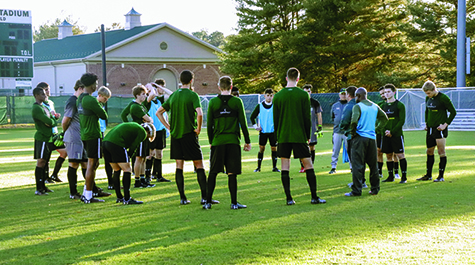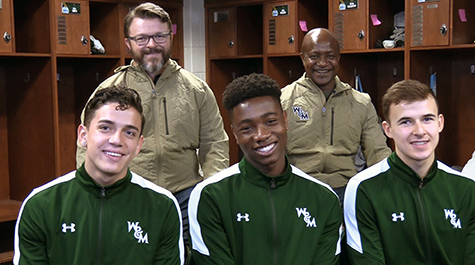Tribe Soccer Players Talk Social and Cultural Adjustments for International Players
By Kelly D. Spence
When freshman Alfredo Bozalongo first came to the United States from Spain, Guatemalan teammate Marcos Villeda contacted him about his interest in a possible roommate agreement.
“It was kind of surprising for me,” Bozalongo said. “I did not expect to have someone on the team that speaks Spanish, so I knew that would be one of the best choices I could make. I’ve been very lucky.”
International recruitment in intercollegiate sports is a growing trend in higher educational institutions in the United States. With over 20,000 international student-athletes within the National Collegiate Athletic Association (NCAA), the international student-athlete contributes much to the diversity and internationalization of their classrooms, campuses and communities.
On Feb. 7, three Tribe men’s soccer players and their coaches sat with Reves staff to discuss the topic of social and cultural adjustments of international student-athletes. The Reves Center would like to send a special thanks to Reeves Trott ’19, former Tribe player, for organizing the discourse.
Joining the discussion was Alfredo Bozalongo ’22 from Spain, Marcos Villeda ’22 from Guatemala and Patrick “Diba” Nwegbo ’22, who was born in the United States, but of parents from Nigeria, West Africa. They make up three of over 700 international students enrolled at William & Mary.
“We have certain things that influence the way that we recruit which, over the years, have caused us to develop a model that we think works for the school here,” said Head Coach Chris Norris ’95, former Tribe soccer player. “We aren’t heavily based on recruiting internationals like a lot of our competitors are, but we really feel strongly about trying to bring in the right international talent to enhance our program.”
International student-athletes experience very different dimensions of the student experience than their domestic counterparts. The presence of international students aids the development of a more cohesive student-oriented culture; however, the transition and developmental experience, especially the social and cultural integration process, can sometimes be challenging.
Cultural heritage is the root of identity, as identity preservation is the keeping of close ties to a support network in the home country—all essential actions for international student-athletes. Bozalongo said that he preserves his culture with frequent phone calls back home.
“As I am from Spain, my family and I have a six-hour difference in time, so I always try to call them every Sunday at 3 p.m. (9 p.m. in Spain), because it’s the perfect time to do a ‘sum up’ of the week and talk about the upcoming week,” Bozalongo stated. “I usually try to FaceTime with them (my parents, sister and uncle) for about an hour.”
Some social adjustments were more difficult for certain players to make.
“The clearest example was eating dinner at 6–7 p.m., as I was used to having my last meal at about 9–10 p.m., so every time I went to bed I was starving,” Bozalongo said.
The players spoke on the relationship between food and culture as Villeda described a recent visit to a local Mexican restaurant, a familiar cuisine freshman Villeda was eager to sample.
“All of the workers were from Central American countries,” Villeda said. “There were two workers that I met there that were Guatemalan. I ordered the burrito and it was very well done.”
“For me, I’ve been very fortunate,” said freshman Nwegbo. “There were two instances where my mom would bring me (West African) food to the games.”
Assistant Coach Jonny Kamara ’92, former Tribe player from Sierra Leone, West Africa, talked about how he ended up attending William & Mary after high school in Indiana.
“My mom and I were in the process of visiting Old Dominion University — William & Mary wasn’t originally considered,” Kamara stated. “Then my mom happened to mention that she had a friend who attended William & Mary and that we should take a look at the school. We did — and the rest is history.”
Institutional support must play a central role in the cultural and social adjustments for international students. “We all come from three different countries but we’ve built great friendships with the help of the coaching staff,” Villeda said.
“Our players, historically, have what they call ‘pre-pre season,’ which our players get together as a group — without the coaches — for five days before the season begins,” Norris said. “That has been good to help freshmen, like these men, to acclimate.”
Bozalongo spoke about William & Mary’s institutional support by suggesting that although the university is making good efforts towards improving the cultural and social adjustments of international students, more could be done to assist those adjusting to the language barrier.
“I think this could be improved, as it can be very helpful for international students, like me, with English as their second language,” Bozalongo said. “I have unexpectedly met other Spanish-speaking peers around campus, at a social gathering or casually about — however, not through an organized institutional event.”
Norris said that the fall semester is the team’s competitive season, so that has been the center of this freshman group’s experience so far. However, during the spring semester, student-athletes have the opportunity to take a spring break vacation: a time to foster and construct a more satisfying cultural transition to the university, team and community.
 Skip to main content
Skip to main content


